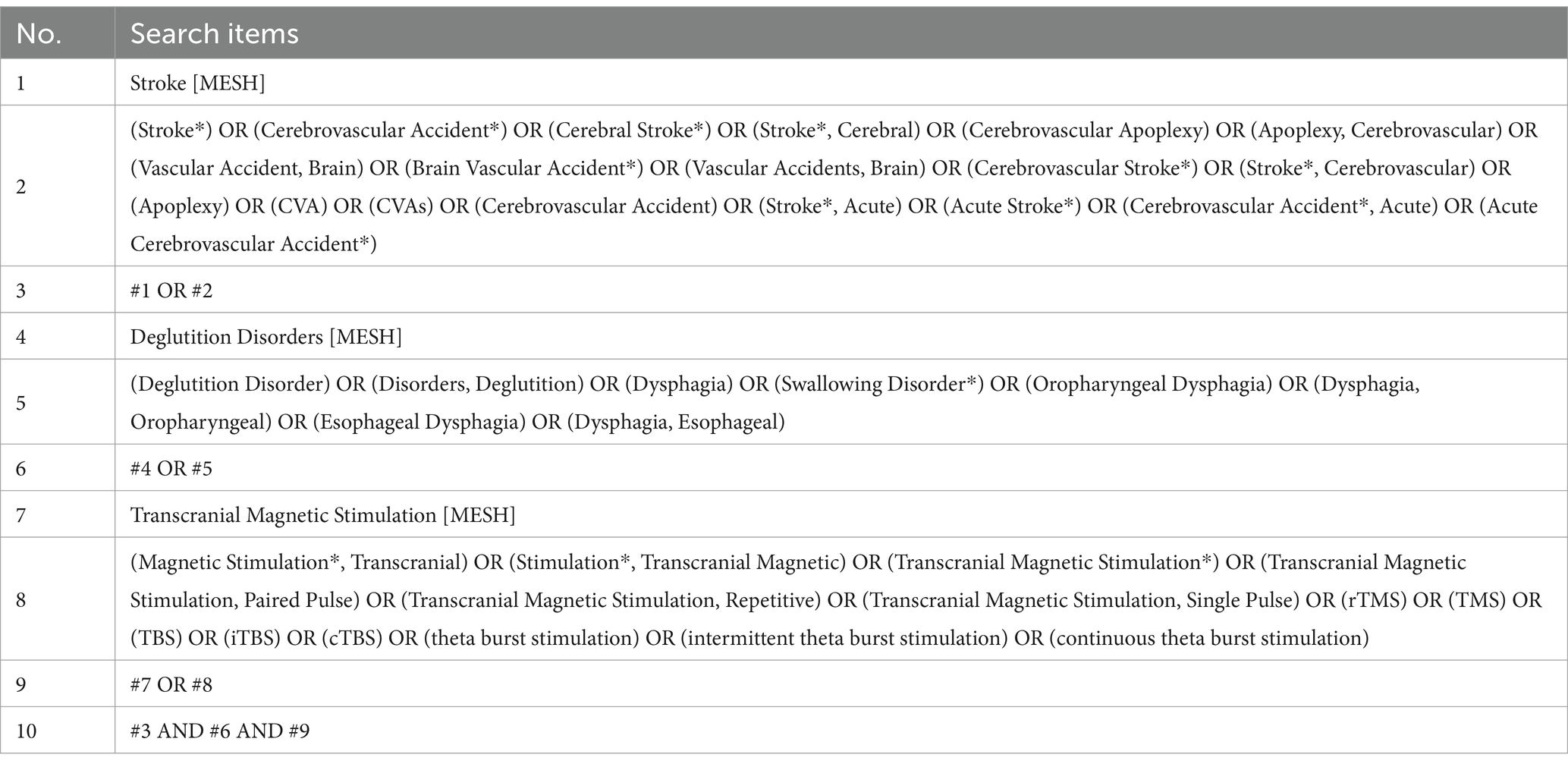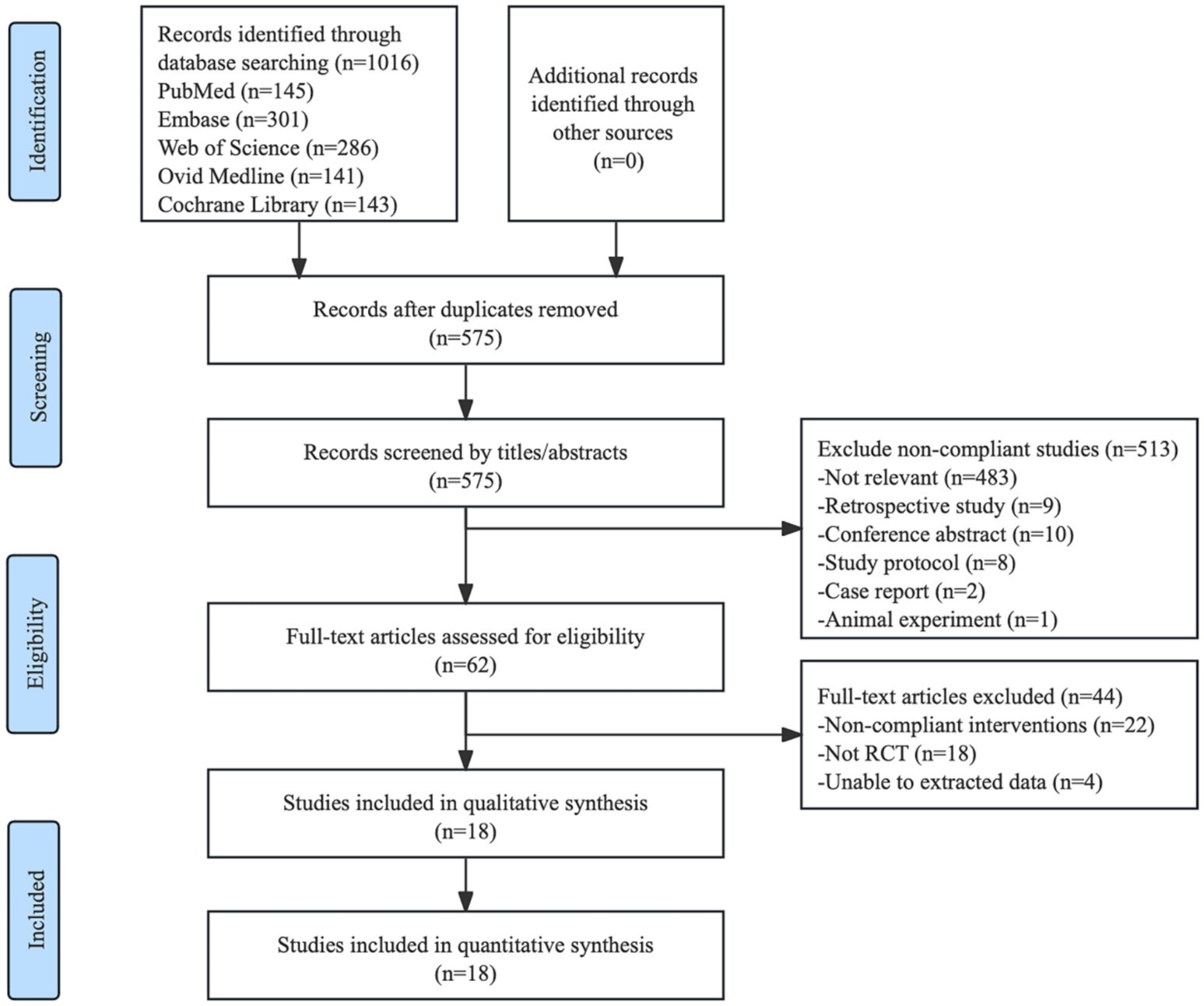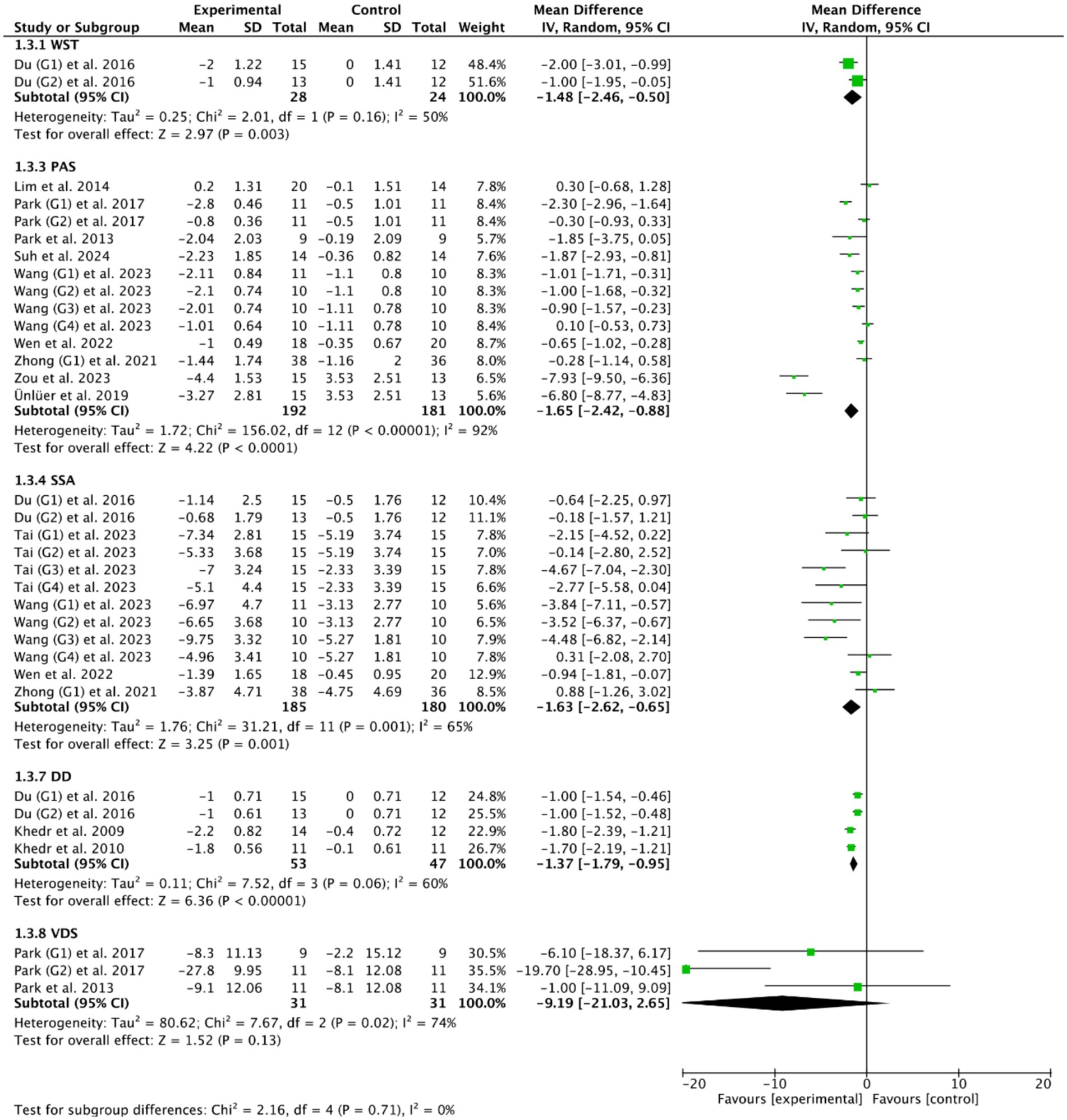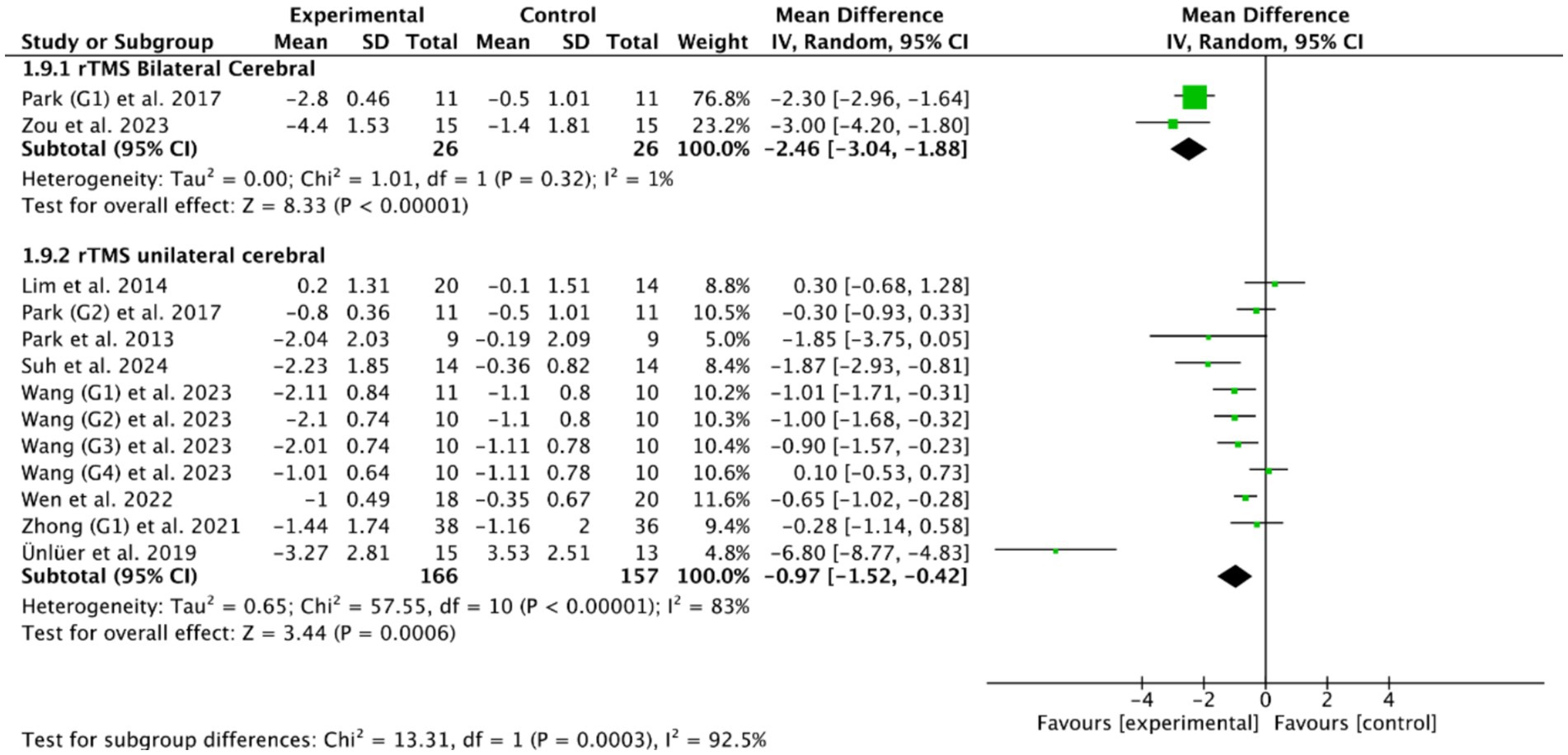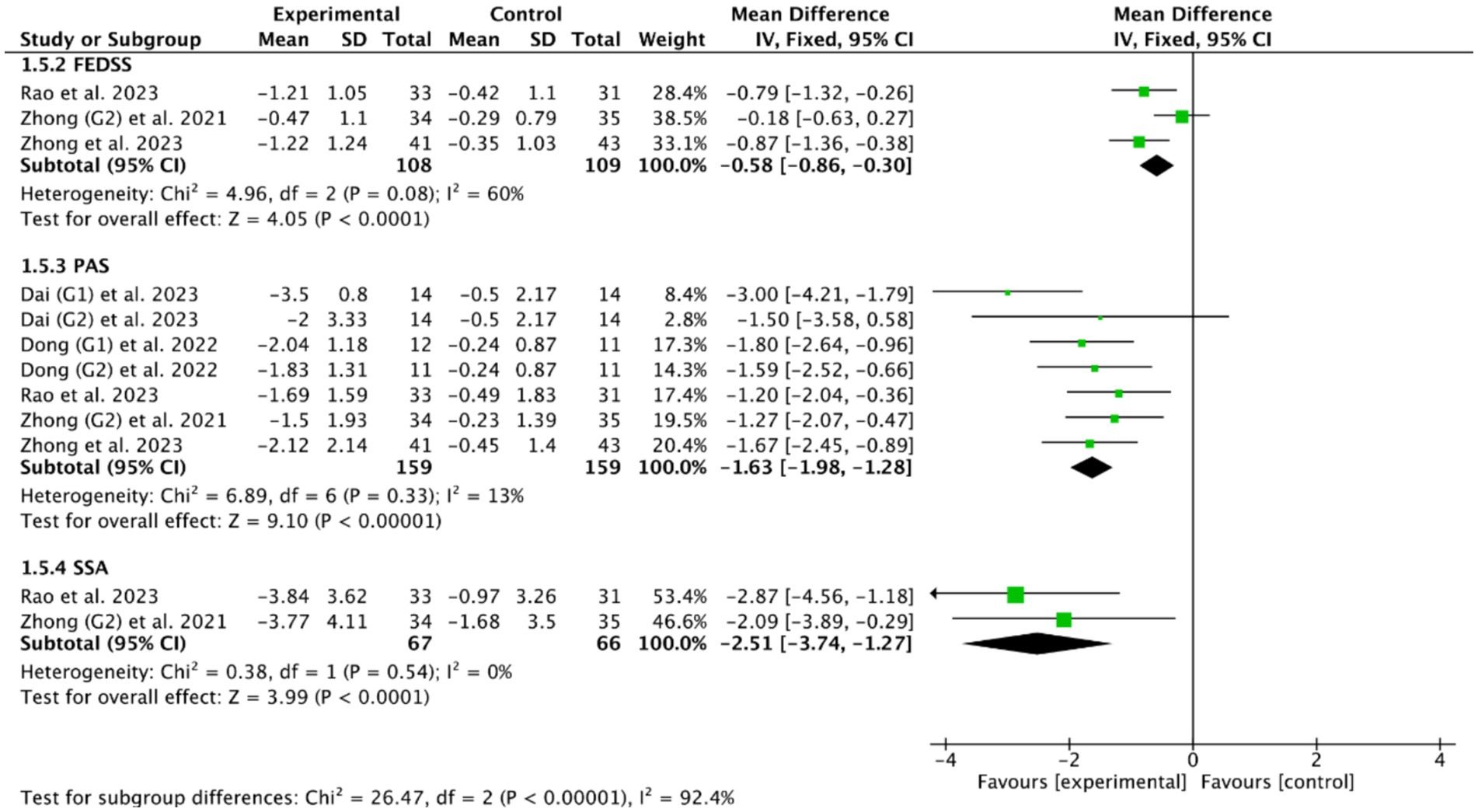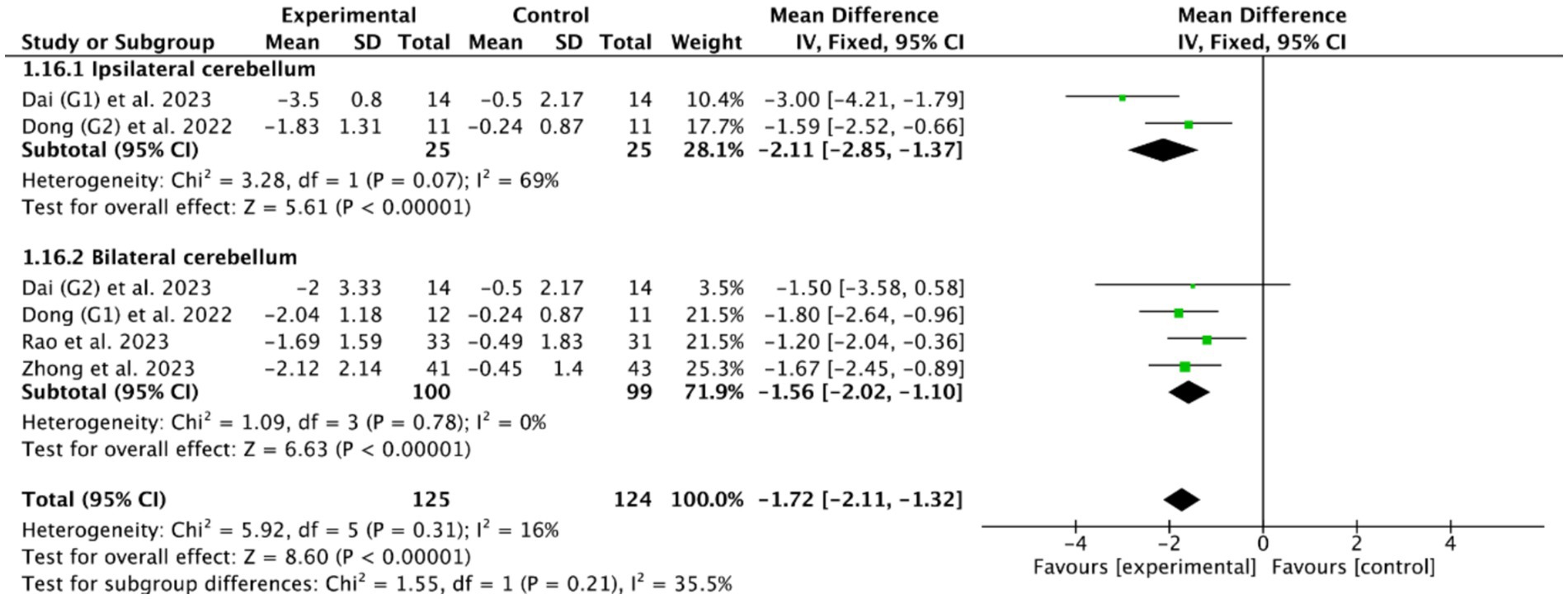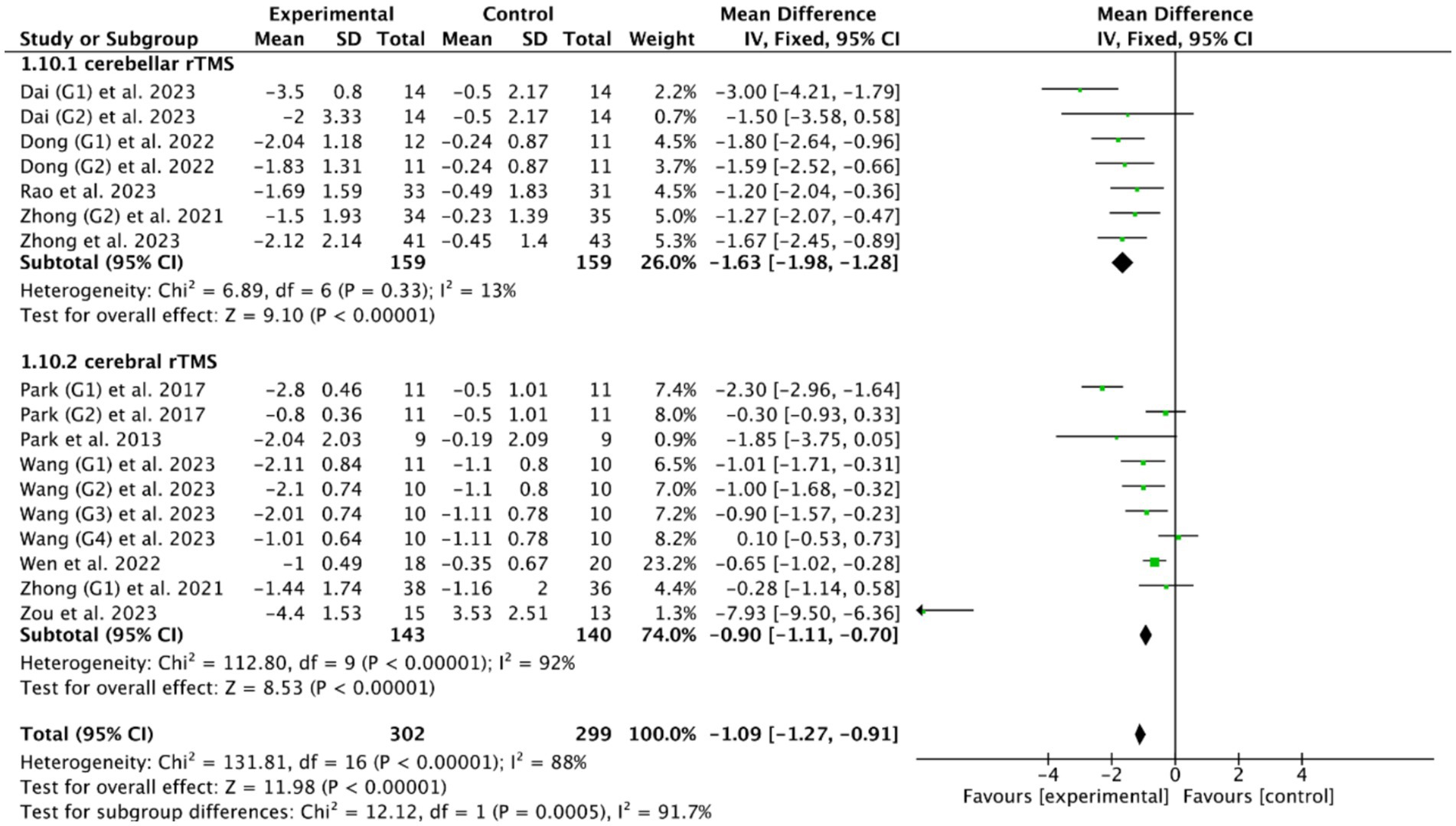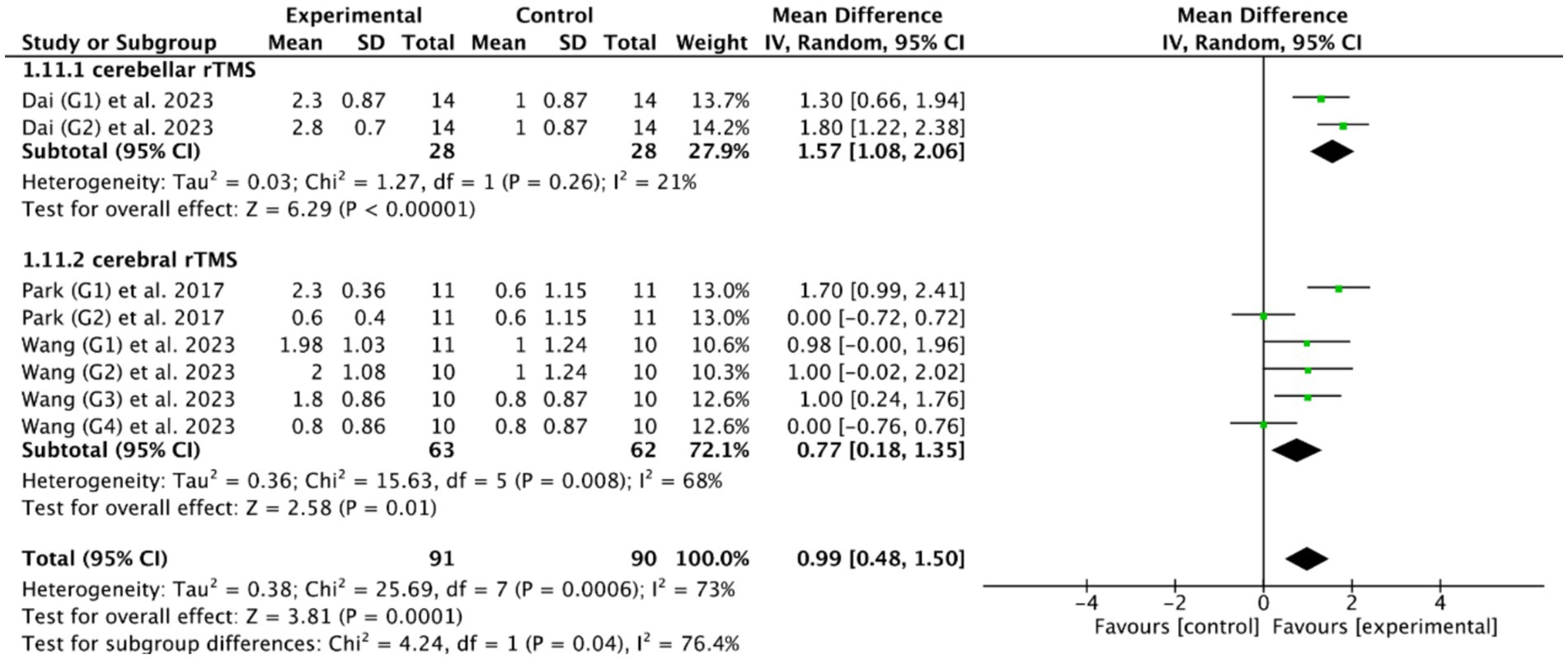- 1College of Rehabilitation, Gannan Medical University, Ganzhou, China
- 2Department of Rehabilitation Medicine, First Affiliated Hospital of Gannan Medical University, Ganzhou, China
- 3Xiangya Hospital, Central South University, Changsha, China
- 4The First Affiliated Hospital of Nanchang University, Nanchang City, Jiangxi Province, China
- 5Department of Neurology, The First Affiliated Hospital of Army Medical University, Army Medical University, Chongqing, China
- 6Ganzhou Intelligent Rehabilitation Technology Innovation Center, Ganzhou, China
- 7Ganzhou Key Laboratory of Rehabilitation Medicine, Ganzhou, China
Background: Previous studies have demonstrated the effectiveness of repetitive transcranial magnetic stimulation (rTMS) in treating post-stroke dysphagia (PSD). However, consensus on optimal clinical protocols for rTMS remains unclear. This study systematically evaluated the efficacy and safety of rTMS with different stimulation parameters in the treatment of PSD to provide evidence-based recommendations for clinical practice.
Methods: Following Preferred Reporting Items for Systematic Reviews and Meta-Analysis (PRISMA) guidelines, related randomized controlled trials (RCTs) were searched across five databases (PubMed, Web of Science, Embase, Cochrane Library, MEDLINE) up to November 2024. Two reviewers independently screened studies, extracted data, and assessed quality using RevMan 5.40. Heterogeneity was evaluated via I2 values, with fixed/random effects models applied accordingly.
Results: A total of 18 RCTs with 835 PSD patients were included in this study. The overall risk of bias in the included trials was evaluated as low, and the level of evidence recommendation was rated as “strong.” Meta-analyses demonstrated that both cerebral and cerebellar rTMS treatments significantly improved the swallowing function of PSD patients (p < 0.05). Subgroup analysis of cerebral rTMS showed that high-frequency rTMS (HF-rTMS) could effectively improve the swallowing function of PSD patients (p < 0.05), while low-frequency rTMS (LF-rTMS) failed to improve the swallowing function of PSD patients compared with the control group (p > 0.05). Furthermore, bilateral cerebral rTMS demonstrated superior efficacy in enhancing swallowing function compared to unilateral cerebral rTMS (p < 0.05). Subgroup analyses based on the Penetration Aspiration Scale (PAS) and Dysphagia Outcome Severity Scale (DOSS) revealed that cerebellar rTMS was more effective than cerebral rTMS in improving swallowing function in patients with PSD (p < 0.05). Regarding safety profiles, only 5 of the 18 RCTs documented mild and transient adverse events, including isolated cases of dizziness, headache, and temporary hearing impairment during treatment sessions.
Conclusion: Both cerebral and cerebellar rTMS therapy can effectively and safely improve swallowing function in patients with PSD. Furthermore, cerebellar rTMS appears to be superior to cerebral rTMS in the treatment of PSD.
Systematic review registration: https://www.crd.york.ac.uk/PROSPERO/view/CRD42024498567.
1 Background
Dysphagia is a common complication following stroke (1), with the incidence ranging from 37 to 78% (2, 3). Post-stroke dysphagia (PSD) frequently precipitates serious complications, including malnutrition, aspiration pneumonia, and electrolyte imbalances, which significantly impede rehabilitation efforts, affect quality of life, and potentially threaten survival (1, 4–6). Current conventional treatments for PSD encompass dietary modifications (7), postural adjustments (8), swallowing rehabilitation exercises (9–11), acupuncture (12, 13), and sensorimotor training (14–16). However, these interventions demonstrate limited efficacy and lack direct modulation of central nervous system governing swallowing function (17).
Repetitive transcranial magnetic stimulation (rTMS) is a non-invasive neuromodulation technique that modifies cortical excitability through repetitive magnetic pulses. Low-frequency rTMS (≤1 Hz; LF-rTMS) inhibits the cortical excitability, while high-frequency rTMS (>1 Hz; HF-rTMS) enhances the cortical excitability (18). rTMS has demonstrated significant advantages in treating PSD. Its non-invasive nature not only improves patient acceptance but also enhances treatment safety. Compared to traditional electrical stimulation therapies, rTMS does not require electrode attachment to the throat (as in neuromuscular electrical stimulation, NMES) or the use of invasive catheters (as in pharyngeal electrical stimulation, PES) (19, 20). Instead, it delivers stimulation non-invasively through the scalp, avoiding local adverse effects such as skin irritation or mucosal damage. Moreover, rTMS is particularly suitable for patients with severe dysphagia as it does not require active patient cooperation. From a safety perspective, rTMS has a low incidence of adverse effects (<5%), primarily manifesting as transient headaches or scalp discomfort, with severe complications such as seizures being extremely rare (18). In contrast, NMES and PES may induce discomfort such as laryngeal spasms or pain. More importantly, in terms of therapeutic mechanisms, traditional electrical stimulation therapies only target peripheral muscle groups, whereas rTMS directly modulates cortical activity in the brain’s swallowing functional areas, promoting neuroplasticity and functional reorganization. This helps restore central neural control over the pharyngeal muscles that have lost innervation (21). Additionally, rTMS offers greater precision and personalization in treatment planning. By measuring motor-evoked potential amplitudes to determine individualized stimulation thresholds, it enables precise control over stimulation intensity. This neurophysiology-based personalized treatment model, compared to the fixed-intensity protocols of traditional electrical stimulation therapies, is not only more scientifically rigorous but also allows for flexible parameter adjustments based on patient responses (22). Consequently, it enhances therapeutic efficacy while reducing the risk of adverse effects. Growing evidence from randomized controlled trials (RCTs) and meta-analyses supports the efficacy of rTMS in with the treatment of PSD (18, 23–30). Moreover, multiple meta-analyses further revealed that rTMS was more effective than transcranial direct current stimulation (tDCS), NMES, and PES in the treatment of PSD (31, 32).
Current research of rTMS for the treatment of PSD vary in stimulation site, frequency, intensity, and modality. For example, some studies showed positive outcomes in the treatment of cerebral rTMS (motor cortex associated with the mylohyoid muscle) (33, 34), while others reported comparable efficacy of cerebellar rTMS treatment (35). Bilateral or unilateral cerebral rTMS treatment also shows different effectiveness (28, 36). Frequency selection remains debated, with both LF-rTMS (37, 38) and HF-rMTS (28, 39, 40) demonstrating therapeutic benefits across studies. This parameter heterogeneity highlights the absence of standardized protocols in clinical practice. This meta-analysis systematically evaluated the efficacy and safety of rTMS with different stimulation parameters in the treatment of PSD, aiming to provide evidence-based recommendations for clinical practice.
2 Methods
This study was designed and implemented in accordance with the Preferred Reporting Items for Systematic Reviews and Meta-Analysis (PRISMA) guidelines (41). The study was registered in Prospero (CRD42024498567).
2.1 Retrieval strategy
For this study, the literature search was independently conducted by two researchers (L-SC and YiL). Five databases including Web of Science, PubMed, Embase, Cochrane Library, and MEDLINE, were searched for relevant studies from the establishment date of the databases until November 2024. The subject terms searched encompassed “Transcranial magnetic stimulation,” “Stroke” and “Dysphagia.” Relevant terms were retrieved through the above subject terms to further broaden the search. The following is an example of our search process in the PubMed database (Table 1).
2.2 Inclusion and exclusion criteria of study
We conducted the literature screening based on pre-defined inclusion and exclusion criteria. The inclusion criteria were as follows: (1) Patients with PSD; (2) The primary intervention was rTMS; (3) The control group received sham stimulation or conventional swallowing intervention; (4) The primary outcome indicator was the assessment of swallowing function; (5) The study was an RCT; (6) The study published in English. The exclusion criteria were: (1) Animal experiments; (2) Duplicated data; (3) Inability to obtain the full text; (4) Missing data and inability to extract complete data.
2.3 Study selection
All retrieved literature was imported into the EndNote 20 reference management software, where duplicate studies were systematically eliminated using the built-in deduplication tool. Two independent reviewers (CG and X-MP) conducted parallel title/abstract screening against predefined inclusion/exclusion criteria. For studies meeting preliminary eligibility requirements, full-text articles were retrieved and subjected to comprehensive evaluation. Discrepancies in screening decisions were resolved through consultation with the principal investigator (YuL), with final determinations made by consensus.
2.4 Data extraction
Two reviewers (CG and X-MP) independently extracted the following parameters from included studies: (1) Bibliometric data: first author, publication year and sample size; (2) Demographic characteristics: sex, age distribution, stroke classification (ischemic/hemorrhagic), lesion localization and disease duration; (3) Intervention protocols: stimulation site coordinates, intensity, frequency (Hz), pulse count per session and total intervention duration. During data extraction, discrepancies or incomplete records were resolved through correspondence with original authors. Studies with unresolved data gaps after three unsuccessful contact attempts were classified as containing incomplete datasets. Inter-rater disagreements were adjudicated by consultation with the principal investigator (YuL) to establish methodological consensus.
2.5 Quality assessment
The quality assessment of included studies was independently conducted by two researchers (CG and X-MP) through a standardized process: initial individual evaluations followed by consensus discussions. The risk of bias assessment was performed using the Cochrane Risk of Bias Tool in Revman 5.40 (42), with results visually represented through a three-tier color-coded system: high risk (red), unclear risk (yellow), and low risk (green). Statistical heterogeneity analysis among studies was conducted using Revman 5.40, with I2 values quantifying heterogeneity levels: ≥75% (high heterogeneity), 50–75% (moderate heterogeneity), 25–50% (low heterogeneity), and when I2 = 0%, the heterogeneity was judged as no heterogeneity (43).
The quality of evidence for the outcome indicators was evaluated using the Grading of Recommendations Assessment, Development, and Evaluation (GRADE) system, which examines aspects such as the limitations, indirectness, inconsistency, and imprecision of the studies (44). The results were evaluated by grading the evidence for the outcome indicators as “high,” “moderate,” “low,” or “very low.” The strength of the recommendations was classified into two levels: “strong” or “weak” (45).
2.6 Statistical analysis
Statistical analyses were performed using Revman 5.40 with the extracted datasets. For meta-analysis implementation, model selection followed heterogeneity thresholds: random-effects models were applied when I2 ≥ 50%, while fixed-effects models were adopted for I2 < 50% cases. Mean Deviation (MD) and 95% Confidence Interval (CI) were used to represent the magnitude of the effect size of the research results.
3 Results
3.1 Literature search findings
A total of 1,016 records were identified through database searches. Following the management of EndNote 20 reference software, 441 duplicates were automatically removed through its deduplication feature. Two independent reviewers conducted title/abstract screening, excluding 513 records based on predefined inclusion/exclusion criteria. The remaining 62 potentially relevant articles underwent full-text evaluation, with exclusions comprising: (1) 18 non-randomized controlled trials; (2) 22 studies employing non-compliant interventions; (3) 4 publications with incomplete datasets. This rigorous process yielded 18 eligible RCTs for further analysis (Figure 1).
3.2 Characteristics of included studies
The 18 included RCTs (27, 28, 33, 37–40, 46–56) encompassed 835 participants with sample sizes ranging from 28 to 143. Of them, there were 515 males and 320 females with PSD. The characteristics of these studies were systematically documented, including sample demographics, stroke classification, lesion topography, disease duration, and validated outcome measures: Penetration Aspiration Scale (PAS), Standardized Swallowing Assessment (SSA), Water Swallow Test (WST), Functional Oral Intake Scale (FOIS), Fiberoptic Endoscopic Dysphagia Severity Scale (FEDSS), Degree of Dysphagia (DD), Videofluoroscopic Dysphagia Scale (VDS), and Dysphagia Outcome Severity Scale (DOSS) (Table 2).
Heterogeneity was observed in rTMS protocols across studies (Table 3). Stimulation parameters varied in (1) stimulation site: cerebral mylohyoid cortex (14 RCTs) vs. cerebellum (5 RCTs); (2) lateralization: unilateral (11 RCTs) vs. bilateral (4 RCTs) approaches, with 3 RCTs combining both; (3) stimulation frequency: HF-rTMS (3 Hz, 5 Hz, 10 Hz, 50 Hz; 13 RCTs) vs. LF-rTMS (1 Hz; 3 RCTs), including 2 RCTs with dual-frequency paradigms.
3.3 Quality assessment result
Methodological quality assessment was performed using the Cochrane Risk of Bias Tool in Revman 5.40. Critical appraisal revealed: (1) Inadequate participant/personnel blinding in 1 study (elevated performance bias risk); (2) Absence of outcome assessor blinding in four studies (detection bias concerns); (3) Unclear selective reporting risks in three studies due to incomplete outcome data disclosure. Notwithstanding these limitations, the majority of included trials demonstrated low overall bias risk (Figures 2, 3).
The GRADE evaluation of primary outcomes identified downgrades in evidence certainty for the WST and VDS metrics, attributed to insufficient sample sizes (n < 100), which led to serious imprecision ratings. Additionally, while the DD scale is clinically convenient and widely adopted, its reliability and validity remain understudied in high-quality research, further diminishing its evidence grade as an informal assessment tool. Consequently, these outcomes were classified as “moderate” (Table 4). In contrast, five swallowing-related measures (PAS, DOSS, FEDSS, SSA, FOIS) maintained “high” ratings, and thus the final evidence recommendation level was “strong.”
3.4 Efficacy of cerebral rTMS
Fourteen RCTs (27, 28, 33, 36–40, 47, 48, 50, 53–55) evaluated the efficacy of cerebral rTMS with mylohyoid motor cortex stimulation by seven standardized metrics: the PAS in nine RCTs (28, 37–40, 52–55), the SSA in five RCTs (27, 36, 50, 53, 55), the DD in three RCTs (27, 47, 48), the VDS in two RCTs (28, 39), the DOSS in two RCTs (28, 55), the FOIS in two RCTs (33, 52), and the WST in only one RCT (27). Figures 4, 5 demonstrated that cerebral rTMS improved the swallowing function evaluated by the WST (MD = −1.48, 95% CI [−2.46, −0.50], p < 0.05), the PAS (MD = −1.65, 95% CI [−2.42, −0.88], p < 0.05), the SSA (MD = −1.63, 95% CI [−2.62, −0.65], p < 0.05), the DD (MD = −1.37, 95% CI [−1.79, −0.95], p < 0.05), the FOIS (MD = 0.73, 95% CI [0.25, 1.20], p < 0.05), and the DOSS (MD = 0.77, 95% CI [0.18, 1.35], p < 0.05) scales, but did not improve the VDS scale (MD = −9.19, 95% CI [−21.03, 2.65], p = 0.13) compared with control group.
3.4.1 Stimulation frequency
Among the 14 RCTs of cerebral rTMS treatment, HF-rTMS (3 Hz, 5 Hz, 10 Hz, 50 Hz) was applied in 9 RCTs (28, 36, 39, 40, 47, 48, 50, 53, 54), LF-rTMS (1 Hz) was applied in 3 RCTs (33, 37, 38), and another 2 RCTs (27, 55) included both HF-rTMS and LF-rTMS. Based on the common outcome indicator PAS (28, 37–40, 52–55), subgroup analysis showed that HF-rTMS (MD = −1.73, 95% CI [−2.63, −0.84], p < 0.05, Figure 6) could effectively improve the swallowing function of PSD patients compared with controls, while LF-rTMS (MD = −1.57, 95% CI [−3.33, 0.19], p > 0.05, Figure 6) failed to improve the swallowing function of PSD patients. However, there was no statistically significant difference between HF-rTMS and LF-rTMS (p = 0.87) in improving the swallowing function of patients with PSD.
3.4.2 Stimulation site
The stimulation site is also an important parameter worthy of attention in the rTMS treatment for patients with PSD. Among the 14 included RCTs, unilateral cerebral rTMS was used in 11 RCTs (27, 33, 36–39, 48, 50, 53–55), and bilateral cerebral rTMS was used in 3 RCTs (28, 40, 47). Based on the common outcome indicator PAS, meta-analysis showed that both bilateral cerebral rTMS (MD = −2.46, 95% CI [−3.04, −1.88], p < 0.05, Figure 7) and unilateral cerebral rTMS (MD = −0.97, 95% CI [−1.52, −0.42], p < 0.05, Figure 7) could effectively improve the swallowing function of patients with PSD compared with the control group. Furthermore, bilateral cerebral rTMS was more effective than unilateral cerebral rTMS in improving the swallowing function of patients with PSD (p < 0.05).
3.4.3 Stimulation intensity
The stimulation intensity is also an important parameter of rTMS. Currently, researchers usually set the stimulation intensity as a percentage of the Resting Motor Threshold (RMT). Fourteen RCTs of cerebral rTMS treatment selected different stimulation intensities, such as 80% RMT, 90% RMT, 100% RMT, 110% RMT, 120% RMT, and 130% RMT. Among them, the stimulation intensities of 80% RMT, 110% RMT, and 130% RMT were each adopted by only one RCT (47, 50, 53). The stimulation intensities of 90% RMT was adopted by five RCTs (27, 28, 38–40), the stimulation intensities of 100% RMT was adopted by three RCTs (27, 37, 55), and the stimulation intensities of 120% RMT was adopted by three RCTs (33, 36, 48). Additionally, the researcher of one RCT adopted the active motor threshold (AMT) and selected 80% AMT as the stimulation intensity (54). These studies all reported that cerebral rTMS with different stimulation intensities could effectively improve the swallowing function in patients with PSD.
3.5 Efficacy of cerebellar rTMS
Among the 18 RCTs we included, 5 RCTs (46, 49, 51, 53, 56) evaluated the efficacy of cerebellar rTMS in patients with PSD by five standardized dysphagia metrics, such as the FEDSS in 3 RCTs (49, 51, 53), the PAS in 5 RCTs (46, 49, 51, 53, 56), the SSA in 2 RCTs (49, 53), the FOIS in 2 RCTs (46, 49), and the DOSS in only one RCT (46). Figures 8, 9 showed that cerebellar rTMS treatment could effectively improve the swallowing function of patients with PSD (FEDSS: MD = −0.58, 95% CI [−0.86, −0.30], p < 0.05; PAS: MD = −1.63, 95% CI [−1.98, −1.28], p < 0.05; SSA: MD = −2.51, 95% CI [−3.74, −1.27], p < 0.05; FOIS: MD = 0.80, 95% CI [0.02, 1.59], p = 0.05; DOSS: MD = 1.57, 95% CI [1.08, 2.06], p < 0.05).
3.5.1 Stimulation frequency
Among the five RCTs (46, 49, 51, 53, 56) of cerebellar rTMS treatment, three RCTs (46, 51, 56) utilized a stimulation frequency of 10 Hz, one RCT (53) employed 5 Hz, and one RCT (49) implemented a specialized protocol using intermittent theta burst stimulation (iTBS) at 50 Hz. Based on the commonly used outcome indicator, the PAS, the meta-analysis showed that cerebellar rTMS at 5 Hz (MD = −1.27, 95% CI [−2.07, −0.47], p < 0.05), cerebellar rTMS at 10 Hz (MD = −1.86, 95% CI [−2.30, −1.42], p < 0.05), and cerebellar rTMS at 50 Hz (MD = −1.20, 95% CI [−2.40, −0.36], p = 0.05, Figure 10) could all effectively improve the swallowing function of patients with PSD compared with the control group.
3.5.2 Stimulation site
Concerning stimulation sites, four RCTs (46, 49, 51, 56) targeted the bilateral cerebellar swallowing functional area (with two of these concurrently investigating ipsilateral cerebellar stimulation), while one RCT (53) did not specify the stimulation location. Based on the commonly used outcome indicator, the PAS, the meta-analysis showed that ipsilateral cerebellar rTMS (MD = −2.11, 95% CI [−2.85, −1.37], p < 0.05) and bilateral cerebellar rTMS (MD = −1.56, 95% CI [−2.02, −1.10], p < 0.05, Figure 11) could both effectively improve the swallowing function of patients with PSD compared with the control group.
3.5.3 Stimulation intensity
Regarding stimulation intensity, the included studies demonstrated variability in intensity: two trials applied 80% RMT (51, 56), with the remaining three employing 90% RMT (46), 100% RMT (49), and 110% RMT (53) respectively. These studies all reported that cerebellar rTMS with different stimulation intensities could effectively improve the swallowing function in patients with PSD.
3.6 The comparison of therapeutic effects between cerebellar and cerebral rTMS
Among the included studies, PAS and DOSS were the most common outcome indicators for PSD: 6 RCTs (28, 39, 40, 52, 53, 55) of cerebral rTMS used PAS as the outcome indicator, and 5 RCTs (46, 49, 51, 53, 56) of cerebellar rTMS used PAS as the outcome indicator; 2 RCTs (28, 55) of cerebral rTMS used DOSS as the outcome indicator, and one RCT (46) of cerebellar rTMS used DOSS as the outcome indicator. The subgroup analysis of 10 RCTs (28, 39, 40, 46, 49, 51–53, 55, 56) based on the PAS outcome indicator showed that both cerebellar rTMS (MD = −1.63, 95% CI [−1.98, −1.28], p < 0.05) and cerebral rTMS (MD = −0.90, 95% CI [−1.11, −0.70], p < 0.05, Figure 12) could effectively improve the swallowing function of patients compared with the control group. Furthermore, cerebellar rTMS was more effective in promoting the recovery of swallowing function than cerebral rTMS (p < 0.05).
Based on the DOSS outcome indicator, the subgroup analysis of 3 RCTs (28, 46, 55) showed that both cerebellar rTMS (MD = 1.57, 95% CI [1.08, 2.06], p < 0.05) and cerebral rTMS (MD = 0.77, 95% CI [0.18, 1.35], p < 0.05, Figure 13) could effectively improve the swallowing function of patients with PSD compared with the control group. Moreover, cerebellar rTMS was superior to cerebral rTMS improve the swallowing function of patients with PSD (p = 0.04).
3.7 Adverse event
Among the 18 included RCTs, only 5 RCTs (37, 38, 53, 55, 56) reported that a small number of patients (< 5%) experienced transient adverse reactions, such as headache, hearing loss, dizziness, and nosebleeds during the trial. And no subject withdrew from the trial study due to severe adverse reactions.
4 Discussion
4.1 The mechanism of rTMS in the treatment of PSD
Cerebral motor cortex and cerebellum are the commonly used stimulation sites of rTMS treatment for PSD. In this study, we included 18 RCTs and found that both cerebral and cerebellar rTMS treatment can effectively and safely improve the swallowing function of PSD patients. This is consistent with previous systematic reviews and meta-analyses (36, 57). For example, Wen et al. (36) included 463 PSD patients from 11 RCTs and revealed that cerebral rTMS treatment could effectively improve the swallowing function of patients with PSD. Similarly, after analyzing 5 RCTs of cerebellar rTMS for the treatment of PSD, Liu et al. (57) also concluded that cerebellar rTMS treatment could effectively improve the swallowing function of patients. Unlike previous findings, our study demonstrated that cerebellar rTMS yielded superior therapeutic effects compared to cerebral rTMS, which may be attributed to differences in their underlying mechanisms.
The normal functioning of swallowing relies on the coordinated action of multiple muscle groups in the face, oropharynx, and esophagus, with its neural control involving a complex network system comprising the cerebral cortex, brainstem, and cerebellum. At the cerebral cortical level, its primary function lies in initiating and regulating voluntary swallowing processes while finely controlling the oropharyngeal phase (58). When stroke damages the cortical swallowing centers, the brain’s ability to control swallowing muscles weakens, leading to swallowing dysfunction. rTMS exerts therapeutic effects by directly modulating cortical excitability: HF-rTMS enhances neuronal excitability in the cortex, inducing long-term potentiation (LTP) effects and activating dormant neural pathways to promote motor signal transmission. In contrast, LF-rTMS suppresses overactive regions, eliciting long-term depression (LTD) effects and restoring balance in brain activity (22). Additionally, rTMS can regulate the metabolism of neurotransmitters such as gamma-aminobutyric acid (GABA), glutamate, and dopamine (59), improving neural function by altering the excitatory-inhibitory balance. Notably, rTMS also promotes the secretion of brain-derived neurotrophic factor (BDNF) (60), which plays a critical role in synaptic plasticity and neuronal survival, facilitating the reconstruction of damaged neural networks.
The cerebellum plays a unique role in swallowing control. Unlike the direct regulation by the cerebral cortex, the cerebellum participates in the fine-tuning of swallowing through modular neural circuits. Although motor commands originate in the cerebral cortex, the cerebellum is crucial for ensuring the accuracy, coordination, and fluidity of muscle activity (61, 62). Anatomically, the cortico-cerebellar tracts transmit neural signals from the motor and sensory cortices to the cerebellum, enabling it to influence multiple swallowing-related neural circuits, including the primary motor area, supplementary motor area, sensory cortex, and cingulate gyrus (63). This parallel operation of multiple circuits suggests that the neural control of swallowing is achieved through interconnected modular networks. Particularly noteworthy is that cerebellar rTMS can not only modulate swallowing function through these neural pathways but also directly stimulate muscle groups involved in swallowing (64, 65), offering a novel therapeutic target for PSD.
4.2 Efficacy of cerebral rTMS with different stimulation parameters
Firstly, stimulation frequency is an important stimulation parameter of rTMS. In the studies we included, different stimulation frequencies were used for cerebral rTMS treatment, including 1 Hz (27, 33, 37, 38, 55), 3 Hz (27, 47, 48), 5 Hz (28, 39, 40, 52, 55), and 50 Hz (50, 54). These studies all reported that cerebral rTMS with different stimulation frequencies could effectively improve the swallowing function in patients with PSD. Furthermore, Meta-analyses showed that HF-rTMS could improve the swallowing function of PSD patients, while LF-rTMS failed to improve the swallowing function of PSD patients compared with controls. Notably, there is no significant difference between HF-rTMS and LF-rTMS in the treatment of PSD, which might be attributable to limited numbers of studies.
Secondly, stimulation site also plays a key role in the treatment of rTMS. In this study, we found that both bilateral cerebral rTMS and unilateral cerebral rTMS could effectively improve the swallowing function of patients with PSD. Notably, bilateral cerebral rTMS was more effective than unilateral cerebral rTMS in the treatment of PSD, probably because swallowing function is controlled by cerebral motor cortex bilaterally (66, 67).
Thirdly, stimulation intensity is another important intervention parameter of rTMS. Different stimulation intensities such as 80% RMT (50), 90% RMT (27, 28, 38–40), 100% RMT (37, 55), 120% RMT (33, 48, 52), and 130% RMT (47), were used for rTMS treatment. These studies all reported that cerebral rTMS with different stimulation intensities could effectively improve the swallowing function in patients with PSD. Current international guidelines of rTMS recommend controlling stimulation intensity in the range of 80–120% of RMT to optimize efficacy while minimizing adverse effects (18).
4.3 Efficacy of cerebellar rTMS with different stimulation parameters
In the studies we included, different stimulation frequencies of cerebellar rTMS were also used for the treatment of PSD, including 5 Hz (53), 10 Hz (46, 51, 56), and 50 Hz (49). All these studies reported that cerebellar rTMS with different stimulation frequencies could effectively improve the swallowing function of PSD patients. A study tested the effects of bilateral cerebellar rTMS with different stimulation frequencies (5 Hz, 10 Hz, and 20 Hz) on swallowing function, and the results showed that only the stimulation frequency of 10 Hz could significantly enhance the amplitude of pharyngeal evoked potentials in the bilateral cerebellar swallowing network (65). Our analysis also showed that 10 Hz is currently the main stimulation frequency of cerebellar rTMS.
In addition, studies have shown that rTMS stimulating either side of the cerebellum can improve the swallowing function of patients (68, 69). Four of five included RCTs (46, 49, 51, 56) adopted bilateral cerebellar targets with consistent positive outcomes. Two of these studies (46, 56) compared the efficacy differences between unilateral and bilateral cerebellar rTMS, and the results revealed that bilateral stimulation was superior to unilateral stimulation, which might be mediated through two mechanisms: (1) Bilateral stimulation enhances functional connectivity across cerebello-cortical pathways, synchronously amplifying cortical excitability in bilateral swallowing networks; (2) Simultaneous activation of bilateral orolingual muscle representations compensates for cortical disconnection, facilitating neuromuscular re-education. These neurophysiological advantages make the bilateral cerebellum an optimal stimulation target of rTMS treatment for PSD.
In the studies we included, different stimulation intensities of cerebellar rTMS were used, including 80% RMT (51, 56), 90%RMT (46), 100%RMT (49), and 110%RMT (53). Notable heterogeneity exists in stimulation intensities across studies, precluding definitive subgroup comparisons. Neuroanatomically, the cerebellum’s extensive connectivity with motor systems raises concerns about potential exacerbation of spasticity through excessive stimulation intensity. Interestingly, our analysis revealed comparable efficacy at 80% RMT, suggesting lower-intensity protocols may balance therapeutic effect and tolerability. However, the optimal intensity requires further investigation through dedicated cerebellar rTMS trials.
4.4 Efficacy of cerebellar rTMS versus cerebral rTMS
To our best knowledge, there are no studies to directly compare the efficacy of cerebral and cerebellar rTMS in the treatment of PSD. In this study, subgroup analysis revealed that cerebellar rTMS appears to be superior to cerebral rTMS in the treatment of PSD evaluated by both PAS and DOSS scores. This differential effect may be attributed to the cerebellum’s unique position in motor network hierarchy—its stimulation simultaneously modulates corticospinal excitability via thalamic relays while directly activating pharyngeal muscle representations (64, 65). Furthermore, cerebellar neuroplasticity mechanisms appear less compromised by stroke-related white matter damage, providing alternative pathways for functional recovery (70). Notably, these promising findings require cautious interpretation due to limited RCTs, which should be verified in the future RCTs.
5 Limitations
This study has several limitations. Firstly, the sample size of the included RCTs was small. A too small sample size can easily lead to biases when assessing the therapeutic effect of rTMS on PSD. Secondly, all the included RCTs involved different types of stroke patients, and the lesion sites of stroke were not consistent, but we were unable to conduct further subgroup analyses. Lastly, the RCTs were limited to those published in English, and no more in-depth search was conducted for RCTs in other languages, so there may be publication bias to a certain extent.
6 Conclusion
This study showed that both cerebral and cerebellar rTMS treatment can effectively and safely improve the swallowing function of PSD patients. Furthermore, cerebellar rTMS appears to be superior to cerebral rTMS in the treatment of PSD, which should be verified in the future RCTs.
Data availability statement
The original contributions presented in the study are included in the article/supplementary material, further inquiries can be directed to the corresponding authors.
Author contributions
X-MP: Conceptualization, Data curation, Formal analysis, Methodology, Software, Writing – original draft. CG: Data curation, Formal analysis, Methodology, Software, Writing – original draft. M-XX: Data curation, Writing – original draft. L-SC: Methodology, Writing – original draft, Software. YiL: Methodology, Writing – original draft, Software. JC: Validation, Writing – review & editing. M-YW: Supervision, Validation, Writing – review & editing. YuL: Project administration, Supervision, Validation, Writing – review & editing.
Funding
The author(s) declare that financial support was received for the research and/or publication of this article. This study was funded by the Science and Technology Program of Jiangxi Provincial Healthcare Commission (202210886) and the Science and Technology Program of Jiangxi Provincial Administration of Traditional Chinese Medicine (2021A309) to YuL.
Conflict of interest
The authors declare that the research was conducted in the absence of any commercial or financial relationships that could be construed as a potential conflict of interest.
Generative AI statement
The authors declare that no Gen AI was used in the creation of this manuscript.
Publisher’s note
All claims expressed in this article are solely those of the authors and do not necessarily represent those of their affiliated organizations, or those of the publisher, the editors and the reviewers. Any product that may be evaluated in this article, or claim that may be made by its manufacturer, is not guaranteed or endorsed by the publisher.
References
1. Martino, R, Foley, N, Bhogal, S, Diamant, N, Speechley, M, and Teasell, R. Dysphagia after stroke: incidence, diagnosis, and pulmonary complications. Stroke. (2005) 36:2756–63. doi: 10.1161/01.STR.0000190056.76543.eb
2. Mann, G, Hankey, GJ, and Cameron, D. Swallowing function after stroke: prognosis and prognostic factors at 6 months. Stroke. (1999) 30:744–8. doi: 10.1161/01.STR.30.4.744
3. Roth, EJ, Lovell, L, Harvey, RL, Heinemann, AW, Semik, P, and Diaz, S. Incidence of and risk factors for medical complications during stroke rehabilitation. Stroke. (2001) 32:523–9. doi: 10.1161/01.STR.32.2.523
4. Cohen, DL, Roffe, C, Beavan, J, Blackett, B, Fairfield, CA, Hamdy, S, et al. Post-stroke dysphagia: a review and design considerations for future trials. Int J Stroke. (2016) 11:399–411. doi: 10.1177/1747493016639057
5. Langhorne, P, Bernhardt, J, and Kwakkel, G. Stroke rehabilitation. Lancet. (2011) 377:1693–702. doi: 10.1016/S0140-6736(11)60325-5
6. Shigematsu, T, and Fujishima, I. Dysphagia and swallowing rehabilitation. Brain Nerve. (2015) 672:169–82. doi: 10.11477/mf.1416200109
7. Reyes-Torres, CA, Castillo-Martínez, L, Reyes-Guerrero, R, Ramos-Vázquez, AG, Zavala-Solares, M, Cassis-Nosthas, L, et al. Design and implementation of modified-texture diet in older adults with oropharyngeal dysphagia: a randomized controlled trial. Eur J Clin Nutr. (2019) 73:989–96. doi: 10.1038/s41430-019-0389-x
8. Terré, R, and Mearin, F. Effectiveness of chin-down posture to prevent tracheal aspiration in dysphagia secondary to acquired brain injury. A videofluoroscopy study. Neurogastroenterol Motil. (2012) 24:414–9. doi: 10.1111/j.1365-2982.2011.01869.x
9. Kılınç, HE, Arslan, SS, Demir, N, and Karaduman, A. The effects of different exercise trainings on suprahyoid muscle activation, tongue pressure force and dysphagia limit in healthy subjects. Dysphagia. (2020) 35:717–24. doi: 10.1007/s00455-019-10079-w
10. Liaw, M-Y, Hsu, C-H, Leong, C-P, Liao, C-Y, Wang, L-Y, Lu, C-H, et al. Respiratory muscle training in stroke patients with respiratory muscle weakness, dysphagia, and dysarthria – a prospective randomized trial. Medicine. (2020) 99:e19337. doi: 10.1097/MD.0000000000019337
11. Lin, C-H, Chung, S-Y, Lin, C-T, and Hwu, Y-J. Effect of tongue-to-palate resistance training on tongue strength in healthy adults. Auris Nasus Larynx. (2021) 48:116–23. doi: 10.1016/j.anl.2020.07.014
12. Chen, D, and Guo, H. Therapeutic effects of acupuncture combined with rehabilitation training on dysphagia in post-stroke pseudobulbar palsy. Zhongguo Zhen Jiu. (2018) 38:364–8. doi: 10.13703/j.0255-2930.2018.04.006
13. Yuan, Y, Cai, X-H, Chen, F, Chen, D-X, Gao, Y, Liu, Z-Z, et al. Clinical trials of acupuncture treatment of post-stroke dysphagia by deep acupuncture of Tiantu (CV22) in combination with swallowing rehabilitation training. Zhen Ci Yan Jiu. (2019) 44:47–50. doi: 10.13702/j.1000-0607.170788
14. Simonelli, M, Ruoppolo, G, Iosa, M, Morone, G, Fusco, A, Grasso, MG, et al. A stimulus for eating. The use of neuromuscular transcutaneous electrical stimulation in patients affected by severe dysphagia after subacute stroke: a pilot randomized controlled trial. NeuroRehabilitation. (2019) 44:103–10. doi: 10.3233/NRE-182526
15. Wang, Z, Wu, L, Fang, Q, Shen, M, Zhang, L, and Liu, X. Effects of capsaicin on swallowing function in stroke patients with dysphagia: a randomized controlled trial. J Stroke Cerebrovasc Dis. (2019) 28:1744–51. doi: 10.1016/j.jstrokecerebrovasdis.2019.02.008
16. Oh, D-H, Park, J-S, Kim, H-J, Chang, M-Y, and Hwang, N-K. The effect of neuromuscular electrical stimulation with different electrode positions on swallowing in stroke patients with oropharyngeal dysphagia: a randomized trial. J Back Musculoskelet Rehabil. (2020) 33:637–44. doi: 10.3233/BMR-181133
17. Zhuang, Y, Wang, X, Yin, X, Li, X, and Liu, W. Exploration of treatment methods for patients with post-stroke dysphagia: a network meta-analysis. Biotechnol Genet Eng Rev. (2024) 40:1–18. doi: 10.1080/02648725.2023.2184044
18. Lefaucheur, J-P, Aleman, A, Baeken, C, Benninger, DH, Brunelin, J, Di Lazzaro, V, et al. Evidence-based guidelines on the therapeutic use of repetitive transcranial magnetic stimulation (rTMS): an update (2014-2018). Clin Neurophysiol. (2020) 131:474–528. doi: 10.1016/j.clinph.2019.11.002
19. Bath, PM, Scutt, P, Love, J, Clavé, P, Cohen, D, Dziewas, R, et al. Pharyngeal electrical stimulation for treatment of dysphagia in subacute stroke: a randomized controlled trial. Stroke. (2016) 47:1562–70. doi: 10.1161/STROKEAHA.115.012455
20. Meng, P, Zhang, S, Wang, Q, Wang, P, Han, C, Gao, J, et al. The effect of surface neuromuscular electrical stimulation on patients with post-stroke dysphagia. J Back Musculoskelet Rehabil. (2018) 31:363–70. doi: 10.3233/BMR-170788
21. Jannati, A, Oberman, LM, Rotenberg, A, and Pascual-Leone, A. Assessing the mechanisms of brain plasticity by transcranial magnetic stimulation. Neuropsychopharmacology. (2023) 48:191–208. doi: 10.1038/s41386-022-01453-8
22. Klomjai, W, Katz, R, and Lackmy-Vallée, A. Basic principles of transcranial magnetic stimulation (TMS) and repetitive TMS (rTMS). Ann Phys Rehabil Med. (2015) 58:208–13. doi: 10.1016/j.rehab.2015.05.005
23. Tan, SW, Wu, A, Cheng, LJ, Wong, SH, Lau, Y, and Lau, ST. The effectiveness of transcranial stimulation in improving swallowing outcomes in adults with poststroke dysphagia: a systematic review and Meta-analysis. Dysphagia. (2022) 37:1796–813. doi: 10.1007/s00455-022-10424-6
24. Li, H, Li, L, Zhang, R, Huang, X, Lin, J, Liu, C, et al. Effectiveness of repetitive transcranial magnetic stimulation on poststroke dysphagia: a meta-analysis of randomized-controlled trials. Int J Rehabil Res. (2022) 45:109–17. doi: 10.1097/MRR.0000000000000517
25. Liao, X, Xing, G, Guo, Z, Jin, Y, Tang, Q, He, B, et al. Repetitive transcranial magnetic stimulation as an alternative therapy for dysphagia after stroke: a systematic review and meta-analysis. Clin Rehabil. (2017) 31:289–98. doi: 10.1177/0269215516644771
26. Yang, W, Cao, X, Zhang, X, Wang, X, Li, X, and Huai, Y. The effect of repetitive transcranial magnetic stimulation on dysphagia after stroke: a systematic review and meta-analysis. Front Neurosci. (2021) 15:769848. doi: 10.3389/fnins.2021.769848
27. Du, J, Yang, F, Liu, L, Hu, J, Cai, B, Liu, W, et al. Repetitive transcranial magnetic stimulation for rehabilitation of poststroke dysphagia: a randomized, double-blind clinical trial. Clin Neurophysiol. (2016) 127:1907–13. doi: 10.1016/j.clinph.2015.11.045
28. Park, E, Kim, MS, Chang, WH, Oh, SM, Kim, YK, Lee, A, et al. Effects of bilateral repetitive transcranial magnetic stimulation on post-stroke dysphagia. Brain Stimul. (2017) 10:75–82. doi: 10.1016/j.brs.2016.08.005
29. Zhang, C, Zheng, X, Lu, R, Yun, W, Yun, H, and Zhou, X. Repetitive transcranial magnetic stimulation in combination with neuromuscular electrical stimulation for treatment of post-stroke dysphagia. J Int Med Res. (2019) 47:662–72. doi: 10.1177/0300060518807340
30. Cheng, IKY, Chan, KMK, Wong, C-S, Li, LSW, Chiu, KMY, Cheung, RTF, et al. Neuronavigated high-frequency repetitive transcranial magnetic stimulation for chronic post-stroke dysphagia: a randomized controlled study. J Rehabil Med. (2017) 49:475–81. doi: 10.2340/16501977-2235
31. Chiang, C-F, Lin, M-T, Hsiao, M-Y, Yeh, Y-C, Liang, Y-C, and Wang, T-G. Comparative efficacy of noninvasive neurostimulation therapies for acute and subacute poststroke dysphagia: a systematic review and network meta-analysis. Arch Phys Med Rehabil. (2019) 100:739–750.e4. doi: 10.1016/j.apmr.2018.09.117
32. Wang, T, Dong, L, Cong, X, Luo, H, Li, W, Meng, P, et al. Comparative efficacy of non-invasive neurostimulation therapies for poststroke dysphagia: a systematic review and meta-analysis. Neurophysiol Clin. (2021) 51:493–506. doi: 10.1016/j.neucli.2021.02.006
33. Tarameshlu, M, Ansari, NN, Ghelichi, L, and Jalaei, S. The effect of repetitive transcranial magnetic stimulation combined with traditional dysphagia therapy on poststroke dysphagia: a pilot double-blinded randomized-controlled trial. Int J Rehabil Res. (2019) 42:133–8. doi: 10.1097/MRR.0000000000000336
34. Hammad, AB, Elhamrawy, EA, Abdel-Tawab, H, Shafik, MA, Sallam, Y, Elzomor, HM, et al. Transcranial magnetic stimulation versus transcutaneous neuromuscular electrical stimulation in post stroke dysphagia: a clinical randomized controlled trial. J Stroke Cerebrovasc Dis. (2022) 31:106554. doi: 10.1016/j.jstrokecerebrovasdis.2022.106554
35. Chen, Q, Huang, H, Chen, G, Chen, J, Fang, F, Lei, H, et al. The effect of cerebellar repetitive transcranial magnetic stimulation on dysphagia due to posterior circulation stroke, a randomized controlled trial protocol. Cerebrovasc Dis. (2022) 51:706–11. doi: 10.1159/000524241
36. Wen, X, Liu, Z, Zhong, L, Peng, Y, Wang, J, Liu, H, et al. The effectiveness of repetitive transcranial magnetic stimulation for post-stroke dysphagia: a systematic review and meta-analysis. Front Hum Neurosci. (2022) 16:841781. doi: 10.3389/fnhum.2022.841781
37. Lim, K-B, Lee, H-J, Yoo, J, and Kwon, Y-G. Effect of low-frequency rTMS and NMES on subacute unilateral hemispheric stroke with dysphagia. Ann Rehabil Med. (2014) 38:592–602. doi: 10.5535/arm.2014.38.5.592
38. Ünlüer, NÖ, Temuçin, ÇM, Demir, N, Serel Arslan, S, and Karaduman, AA. Effects of low-frequency repetitive transcranial magnetic stimulation on swallowing function and quality of life of post-stroke patients. Dysphagia. (2019) 34:360–71. doi: 10.1007/s00455-018-09965-6
39. Park, JW, Oh, JC, Lee, JW, Yeo, JS, and Ryu, KH. The effect of 5Hz high-frequency rTMS over contralesional pharyngeal motor cortex in post-stroke oropharyngeal dysphagia: a randomized controlled study. Neurogastroenterol Motil. (2013) 25:324–e250. doi: 10.1111/nmo.12063
40. Zou, F, Chen, X, Niu, L, Wang, Y, Chen, J, Li, C, et al. Effect of repetitive transcranial magnetic stimulation on post-stroke dysphagia in acute stage. Dysphagia. (2023) 38:1117–27. doi: 10.1007/s00455-022-10533-2
41. Liberati, A, Altman, DG, Tetzlaff, J, Mulrow, C, Gøtzsche, PC, Ioannidis, JPA, et al. The PRISMA statement for reporting systematic reviews and meta-analyses of studies that evaluate health care interventions: explanation and elaboration. PLoS Med. (2009) 6:e1000100. doi: 10.1371/journal.pmed.1000100
42. Higgins, JPT, Altman, DG, Gøtzsche, PC, Jüni, P, Moher, D, Oxman, AD, et al. The Cochrane Collaboration's tool for assessing risk of bias in randomised trials. BMJ. (2011) 343:d5928. doi: 10.1136/bmj.d5928
43. Higgins, JPT, Thompson, SG, Deeks, JJ, and Altman, DG. Measuring inconsistency in meta-analyses. BMJ. (2003) 327:557–60. doi: 10.1136/bmj.327.7414.557
44. Goldet, G, and Howick, J. Understanding GRADE: an introduction. J Evid Based Med. (2013) 6:50–4. doi: 10.1111/jebm.12018
45. Guyatt, G, Oxman, AD, Akl, EA, Kunz, R, Vist, G, Brozek, J, et al. GRADE guidelines: 1. Introduction-GRADE evidence profiles and summary of findings tables. J Clin Epidemiol. (2011) 64:383–94. doi: 10.1016/j.jclinepi.2010.04.026
46. Dai, M, Qiao, J, Shi, Z, Wei, X, Chen, H, Shen, L, et al. Effect of cerebellar transcranial magnetic stimulation with double-cone coil on dysphagia after subacute infratentorial stroke: a randomized, single-blinded, controlled trial. Brain Stimul. (2023) 16:1012–20. doi: 10.1016/j.brs.2023.05.023
47. Khedr, EM, and Abo-Elfetoh, N. Therapeutic role of rTMS on recovery of dysphagia in patients with lateral medullary syndrome and brainstem infarction. J Neurol Neurosurg Psychiatry. (2010) 81:495–9. doi: 10.1136/jnnp.2009.188482
48. Khedr, EM, Abo-Elfetoh, N, and Rothwell, JC. Treatment of post-stroke dysphagia with repetitive transcranial magnetic stimulation. Acta Neurol Scand. (2009) 119:155–61. doi: 10.1111/j.1600-0404.2008.01093.x
49. Rao, J, Li, F, Zhong, L, Wang, J, Peng, Y, Liu, H, et al. Bilateral cerebellar intermittent Theta burst stimulation combined with swallowing speech therapy for dysphagia after stroke: a randomized, double-blind, sham-controlled, clinical trial. Neurorehabil Neural Repair. (2022) 36:437–48. doi: 10.1177/15459683221092995
50. Tai, J, Hu, R, Fan, S, Wu, Y, Wang, T, and Wu, J. Theta-burst transcranial magnetic stimulation for dysphagia patients during recovery stage of stroke: a randomized controlled trial. Eur J Phys Rehabil Med. (2023) 59:543–53. doi: 10.23736/S1973-9087.23.08023-1
51. Zhong, L, Wen, X, Liu, Z, Li, F, Ma, X, Liu, H, et al. Effects of bilateral cerebellar repetitive transcranial magnetic stimulation in poststroke dysphagia: a randomized sham-controlled trial. NeuroRehabilitation. (2023) 52:227–34. doi: 10.3233/NRE-220268
52. Wen, X, Yang, Q, Liu, Z, Peng, Y, Wang, J, Liu, X, et al. The effect of repetitive transcranial magnetic stimulation in synchronization with effortful swallowing on post-stroke dysphagia. Dysphagia. (2023) 38:912–22. doi: 10.1007/s00455-022-10515-4
53. Zhong, L, Rao, J, Wang, J, Li, F, Peng, Y, Liu, H, et al. Repetitive transcranial magnetic stimulation at different sites for dysphagia after stroke: a randomized, observer-blind clinical trial. Front Neurol. (2021) 12:625683. doi: 10.3389/fneur.2021.625683
54. Suh, I, You, J, Son, S, Bae, JS, and Lim, JY. The effect of real versus sham intermittent theta burst transcranial magnetic stimulation combined with conventional treatment on poststroke dysphagia: a randomized controlled trial. Int J Rehabil Res. (2024) 47:81–6. doi: 10.1097/MRR.0000000000000621
55. Wang, L, Wang, F, Lin, Y, Guo, X, Wang, J, Liu, J, et al. Treatment of post-stroke dysphagia with repetitive transcranial magnetic stimulation based on the bimodal balance recovery model: a pilot study. J Integr Neurosci. (2023) 22:53. doi: 10.31083/j.jin2203053
56. Dong, L-H, Pan, X, Wang, Y, Bai, G, Han, C, Wang, Q, et al. High-frequency cerebellar rTMS improves the swallowing function of patients with dysphagia after brainstem stroke. Neural Plast. (2022) 2022:6259693–9. doi: 10.1155/2022/6259693
57. Liu, Y, Yin, S, Yang, X, Luo, S, Zhu, F, Zeng, Z, et al. Effects of cerebellar repetitive transcranial magnetic stimulation in the treatment of post-stroke dysphagia: a meta-analysis and systematic review of randomized controlled trials. Eur Neurol. (2024) 87:67–78. doi: 10.1159/000538130
58. Jean, A. Brain stem control of swallowing: neuronal network and cellular mechanisms. Physiol Rev. (2001) 81:929–69. doi: 10.1152/physrev.2001.81.2.929
59. Caballero-Villarraso, J, Medina, FJ, Escribano, BM, Agüera, E, Santamaría, A, Pascual-Leone, A, et al. Mechanisms involved in neuroprotective effects of transcranial magnetic stimulation. CNS Neurol Disord Drug Targets. (2022) 21:557–73. doi: 10.2174/1871527320666210809121922
60. Xing, Y, Zhang, Y, Li, C, Luo, L, Hua, Y, Hu, J, et al. Repetitive transcranial magnetic stimulation of the brain after ischemic stroke: mechanisms from animal models. Cell Mol Neurobiol. (2023) 43:1487–97. doi: 10.1007/s10571-022-01264-x
61. Roostaei, T, Nazeri, A, Sahraian, MA, and Minagar, A. The human cerebellum: a review of physiologic neuroanatomy. Neurol Clin. (2014) 32:859–69. doi: 10.1016/j.ncl.2014.07.013
62. Daskalakis, ZJ, Paradiso, GO, Christensen, BK, Fitzgerald, PB, Gunraj, C, and Chen, R. Exploring the connectivity between the cerebellum and motor cortex in humans. J Physiol. (2004) 557:689–700. doi: 10.1113/jphysiol.2003.059808
63. Mosier, K, and Bereznaya, I. Parallel cortical networks for volitional control of swallowing in humans. Exp Brain Res. (2001) 140:280–9. doi: 10.1007/s002210100813
64. Harrington, A, and Hammond-Tooke, GD. Theta burst stimulation of the cerebellum modifies the TMS-evoked N100 potential, a marker of GABA inhibition. PLoS One. (2015) 10:e0141284. doi: 10.1371/journal.pone.0141284
65. Casula, EP, Pellicciari, MC, Ponzo, V, Stampanoni Bassi, M, Veniero, D, Caltagirone, C, et al. Cerebellar theta burst stimulation modulates the neural activity of interconnected parietal and motor areas. Sci Rep. (2016) 6:36191. doi: 10.1038/srep36191
66. Hamdy, S, Aziz, Q, Rothwell, JC, Crone, R, Hughes, D, Tallis, RC, et al. Explaining oropharyngeal dysphagia after unilateral hemispheric stroke. Lancet. (1997) 350:686–92. doi: 10.1016/S0140-6736(97)02068-0
67. Hamdy, S, Aziz, Q, Rothwell, JC, Singh, KD, Barlow, J, Hughes, DG, et al. The cortical topography of human swallowing musculature in health and disease. Nat Med. (1996) 2:1217–24. doi: 10.1038/nm1196-1217
68. Vasant, DH, Michou, E, Mistry, S, Rothwell, JC, and Hamdy, S. High-frequency focal repetitive cerebellar stimulation induces prolonged increases in human pharyngeal motor cortex excitability. J Physiol. (2015) 593:4963–77. doi: 10.1113/JP270817
69. Sasegbon, A, Watanabe, M, Simons, A, Michou, E, Vasant, DH, Magara, J, et al. Cerebellar repetitive transcranial magnetic stimulation restores pharyngeal brain activity and swallowing behaviour after disruption by a cortical virtual lesion. J Physiol. (2019) 597:2533–46. doi: 10.1113/JP277545
Keywords: stroke, dysphagia, repetitive transcranial magnetic stimulation, meta-analysis, randomized controlled trial
Citation: Peng X-M, Gong C, Xiao M-X, Chen L-S, Li Y, Chen J, Wang M-Y and Luo Y (2025) Effect of repetitive transcranial magnetic stimulation with different stimulation parameters on post-stroke dysphagia: a systematic review and meta-analysis of randomized controlled trials. Front. Neurol. 16:1586734. doi: 10.3389/fneur.2025.1586734
Edited by:
Mariano Serrao, Sapienza University of Rome, ItalyCopyright © 2025 Peng, Gong, Xiao, Chen, Li, Chen, Wang and Luo. This is an open-access article distributed under the terms of the Creative Commons Attribution License (CC BY). The use, distribution or reproduction in other forums is permitted, provided the original author(s) and the copyright owner(s) are credited and that the original publication in this journal is cited, in accordance with accepted academic practice. No use, distribution or reproduction is permitted which does not comply with these terms.
*Correspondence: Jie Chen, Y2hlbmppZTEyMjEwMDBAMTYzLmNvbQ==; Mao-Yuan Wang, d215LmdtdS5rZkBnbWFpbC5jb20=; Yun Luo, NzM1MDgzNTY2QHFxLmNvbQ==
†These authors have contributed equally to this work and share first authorship
 Xu-Miao Peng
Xu-Miao Peng Cheng Gong
Cheng Gong Mei-Xia Xiao4†
Mei-Xia Xiao4† Liang-Sheng Chen
Liang-Sheng Chen Jie Chen
Jie Chen Mao-Yuan Wang
Mao-Yuan Wang Yun Luo
Yun Luo